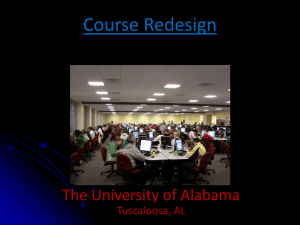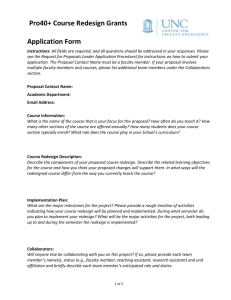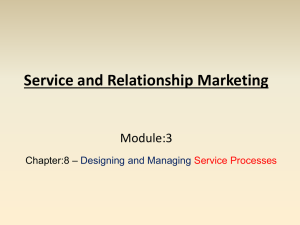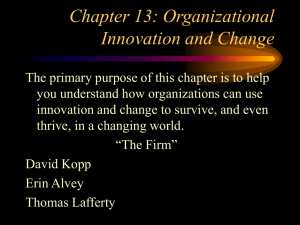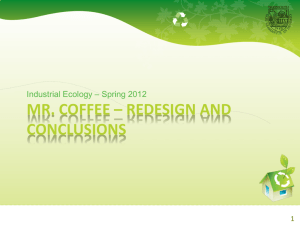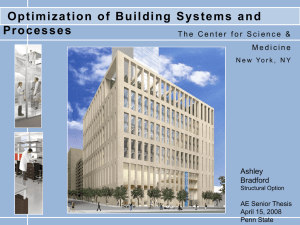ppt - APSE-MO
advertisement
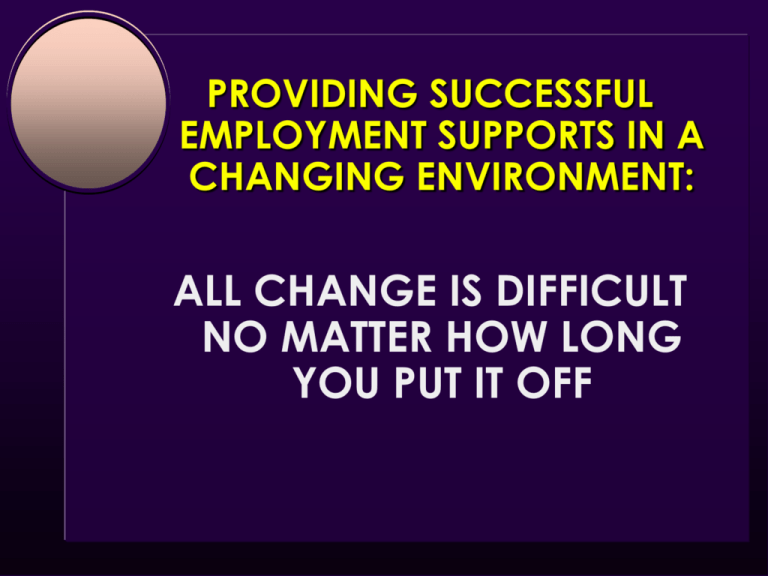
PROVIDING SUCCESSFUL EMPLOYMENT SUPPORTS IN A CHANGING ENVIRONMENT: ALL CHANGE IS DIFFICULT NO MATTER HOW LONG YOU PUT IT OFF “ A MAN’S WOMENFOLK, WHATEVER THEIR OUTWARD SHOW OF RESPECT FOR HIS MERIT & AUTHORITY, ALWAYS REGARD HIM SECRETLY AS AN ASS, AND WITH SOMETHING AKIN TO PITY.” H. L. MENCKEN “I feel so miserable without you, it's almost like having you here." Stephen Bishop JOE MARRONE INSTITUTE FOR COMMUNITY INCLUSION MAIN OFFICE: BOSTON, MA NW OFFICE: 4517 NE CESAR CHAVEZ BLVD PORTLAND, OR 97211-8124 TEL: 503-331-0687 CELL: 503-490-2072 FAX: 503-961-7714 EMAIL: joseph.marrone@gmail.com WEB: WWW.COMMUNITYINCLUSION.ORG “ I CAN’T UNDERSTAND WHY PEOPLE ARE FRIGHTENED OF NEW IDEAS; I’M FRIGHTENED OF THE OLD ONES.” JOHN CAGE, COMPOSER “LIFE LIVED WITHIN THE CONFINES OF THE HUMAN SERVICE & REHABILITATION LANDSCAPE IS A LIFE IN WHICH THE FREEDOM TO BECOME & MAKE YOUR OWN FUTURE IS DIMINISHED” PATRICIA DEEGAN 20th World Congress Rehab International: Oslo, Norway – JUNE 2004 ROLE/ LIMITS OF TRAINING AS A CHANGE STRATEGY? REMEMBER THE TURKEY AND THE SQUIRREL ANALOGY Henry Rosovsky Economic Historian “Never underestimate the difficulty of changing false beliefs by facts.” IF PEOPLE CAN WORK PEOPLE SHOULD WORK HOW PATIENT SHOULD WE BE? “TIME IS JUST AS IMPORTANT TO PEOPLE WITH DISABILITIES AS IT IS TO THE REST OF US”GERALD PROVENCAL “ A JOURNEY OF 1000 MILES BEGINS WITH THE FIRST STEP– UNFORTUNATELY A JOURNEY OF 3 STEPS BEGINS THE SAME WAY”MARRONE APHORISM A ship in harbor is safe -but that is not what ships are built for. John A. Shedd Salt from My Attic, 1928 WHY ARE HIGHER OUTCOMES/ EXPECTATIONS NOT ENDORSED BY ADVOCATES RATHER THAN FEARED AS “CREAMING”? DON’T THERE NEED TO BE WINNERS AND LOSERS OR ELSE HAS ANYTHING CHANGED? “The nature of passive resistance within a nonprofit setting is at levels that could teach Gandhi lessons.” Reynold Levy President of Lincoln Center for the Performing Arts, and former president of International Rescue Committee Thom Hartman “ADD, An Alternate View” “I am not inattentive, you are just boring.“ GOETHE “Knowing is not enough; we must apply. Willing is not enough; we must do.” HASN’T THERE BEEN MORE CHANGE IN WELFARE REFORM IN LESS THAN A DECADE THAN IN SUPPORTED EMPLOYMENT IN 20+ YEARS? AMBROSE BIERCE “ PATIENCE: A MINOR FORM OF DESPAIR --DISGUISED AS A VIRTUE.” HELPING PEOPLE (AND SYSTEMS) CHANGE: HOPE, HELP, AND HASSLING COLLABORATION DON’T ASK BEFORE YOU GIVE SOMETHING FIRST ALWAYS SAY YES TO FIRST LEVELS OF CHANGE: • YOURSELF • YOUR ORGANIZATION • OTHER SYSTEMS EDWARD ABBEY One man alone can be pretty dumb sometimes, but for real bona fide stupidity, there ain't nothin' can beat teamwork. SHOOK, J. (2010) HOW TO CHANGE A CULTURE. MIT SLOAN MGMT REVIEW, 51 (2), 62-68 WHAT PEOPLE DO VALUES- ATTITUDES CULTURE SHOOK, J. (2010) HOW TO CHANGE A CULTURE. MIT SLOAN MGMT REVIEW, 51 (2), 62-68 WHAT PEOPLE DO VALUES- ATTITUDES CULTURE ORGANIZATIONAL CHANGE INTERNAL WANT TO CHANGE ORGANIZATIONAL CHANGE EXTERNAL NEED TO CHANGE CRISIS OR PRESSURE ORGANIZATIONAL CHANGE VISION and VALUES KNOW WHAT TO CHANGE TO 5 SIGNS TO RECOGNIZE SYSTEM CHANGE: Grieff, D., Proscio, T., & Wilkins, C. (2003). Laying a new foundation: Changing the systems that create and sustain supportive housing. Oakland, CA: Corporation for Supportive Housing 5 SIGNS TO RECOGNIZE SYSTEM CHANGE: CHANGE IN POWER: Designated positions— people with formal authority—responsible for the new activity (not just individuals who care about it). 5 SIGNS TO RECOGNIZE SYSTEM CHANGE: CHANGE IN MONEY: Routine funding is earmarked for the new activity in a new [new money, shift in existing funding, or new priorities & criteria for accessing money]. 5 SIGNS TO RECOGNIZE SYSTEM CHANGE: CHANGE IN HABITS: Participants in a system interact with each other to carry out the new activity as part of their normal routine not just respond to special initiatives, demonstrations, or projects. 5 SIGNS TO RECOGNIZE SYSTEM CHANGE: CHANGE IN TECHNOLOGY OR SKILLS: Growing cadre of skilled practitioners at most levels in the delivery chain, practicing methods not previously common or considered desirable. Practitioners are now expert in skills that new system demands & have set a standard for effective delivery of results. 5 SIGNS TO RECOGNIZE SYSTEM CHANGE: CHANGE IN IDEAS OR VALUES: New definition of performance or success, & often a new understanding of the people to be served & the problem to be solved [i.e., new goals]. The new definition & understanding are commonly held among most actors in the system, & are no longer in great dispute “ YOU NEED A LITTLE LOVE IN YOUR LIFE & FOOD IN YOUR STOMACH BEFORE YOU CAN HOLD STILL FOR SOME DAMN FOOL’S LECTURE ABOUT HOW TO BEHAVE.” BILLIE HOLIDAY John P. Kotter (1998). Leading change: why transformation efforts fail. In: Harvard Business Review on Change. Cambridge: Harvard Business School Press. Error #1: Not establishing a great enough sense of urgency. In the eyes of stakeholders, how important and urgent is the adoption of a community employment model? Are people so comfortable with the status quo that they will not want to take the effort and risks associated with change? Are a significant portion of the key “stakeholders” (i.e., people with authority or influence or ideally both) honestly convinced that “business as usual” is totally unacceptable? Bottom line: Is there a system-wide perception of urgency? Error #2: Not creating a powerful enough guiding coalition. Which stakeholders are driving the system redesign? Which stakeholder groups are indifferent? Which are opposed? Do the people “pushing the change” have the means to create incentives and modify the organizational infrastructure to support the system redesign? Who are the strong, credible, and assertive leaders who will communicate the need for change to all in the system? Bottom line: Do the people driving change have the means to make it happen? Error #3: Lacking a vision Is there a clearly articulated vision of what we are doing and why? Does the vision easily translate into actions? Is the vision concise and easily understandable (The “rule”: If you can’t explain it easily within 3 – 5 minutes, you don’t really know it)? Is there a clear link between the vision and each specific system redesign activity? Bottom line: Is there a clear theme and blueprint showing how the various system redesign initiatives relate to a vision, or is system redesign perceived as a collection of disparate activities with no central theme? Error #4: Undercommunicating vision by a factor of ten. How has the vision been communicated? Do people “get it”? Are day-to-day actions of the system’s leadership & the guiding coalition consistent with the vision? Are we practicing what we preach? Are we using every possible communication channel to communicate the vision? Are we willing & able to displace nonessential, generic training programs & devote resources to training specific to community employment for people with significant disabilities? Bottom line: How effectively have we communicated the vision? Error #5: Not removing obstacles to new vision. Have we identified the obstacles? Are we willing to make changes in the existing organizational structures if those structures do not support system redesign? How will the system handle administrators, supervisors, and/or managers that do not support change and make demands on their employees that undermine system redesign? Bottom line: Are we willing and able to take the actions necessary to manage organizational and personnel obstacles? Error #6: Not systematically planning for and creating short-term wins. What are some potential short-term wins that would get system redesign off to a positive start? Do we have the commitment to devote resources to creating short-term wins? Bottom line: Are we willing and able to do what it takes to create short-term wins? Error #7: Declaring victory too soon. Does the system have the long-term perspective to maintain the system redesign initiative over time? Do the stakeholders recognize that change requires years, not months? Bottom line: Is there a plan to orchestrate a series of short-term wins so that momentum is sustained? Error #8: Not anchoring changes in the organization’s culture. How can we create an employment “culture” within the local system? How can we develop a broad base of support so that community employment efforts are not restricted to a small circle of advocates? Bottom line: How do we make community employment such an integral part of the development disabilities system so that it is self-sustaining? “ ANY TIME YOU THINK YOU HAVE INFLUENCE, TRY ORDERING AROUND SOMEONE ELSE’S DOG” OLD YIDDISH PROVERB If 1 person calls you a jackass, ignore him; If a second person calls you a jackass, think about it; If a third person calls you a jackass- get a saddle.


